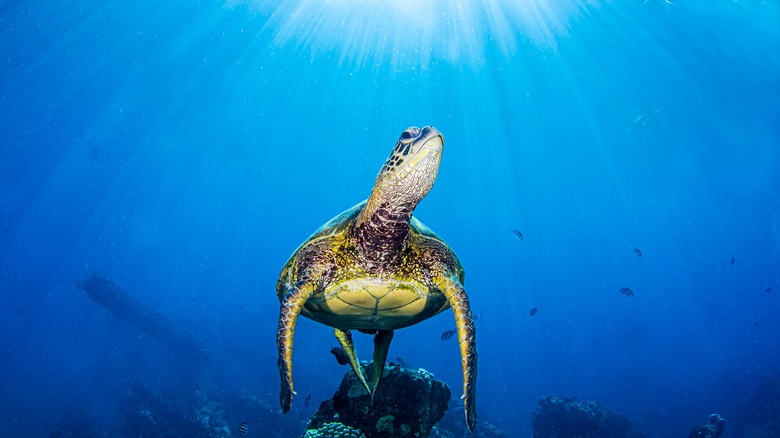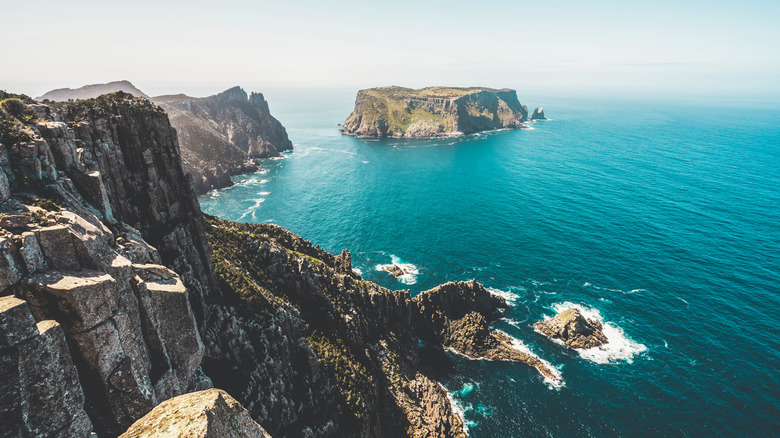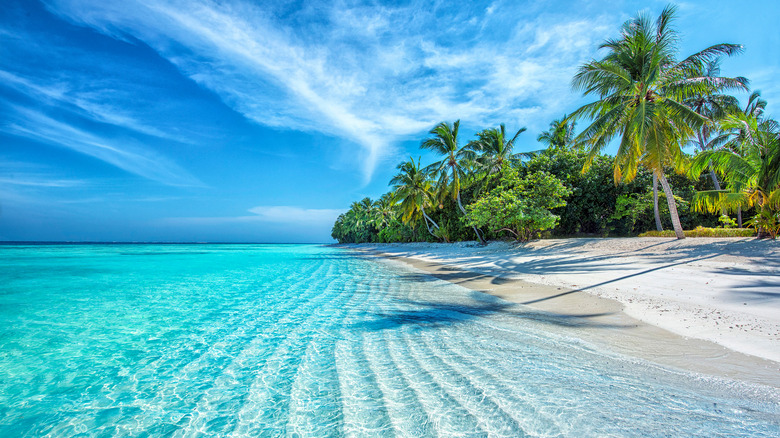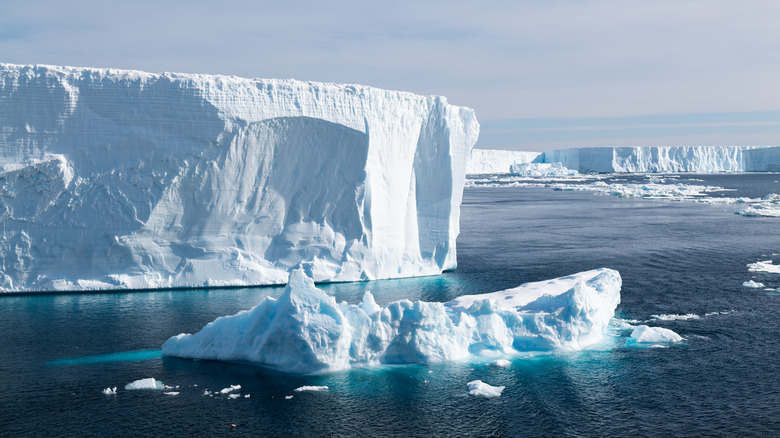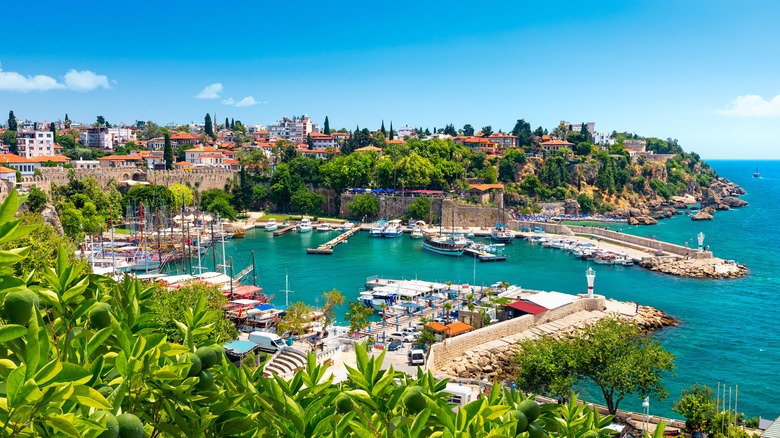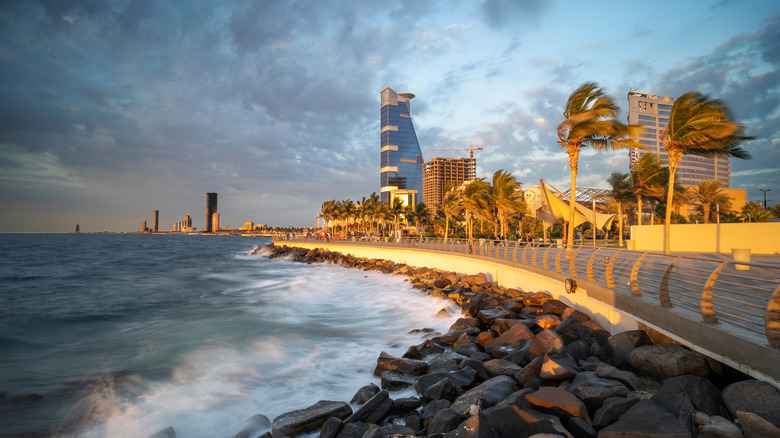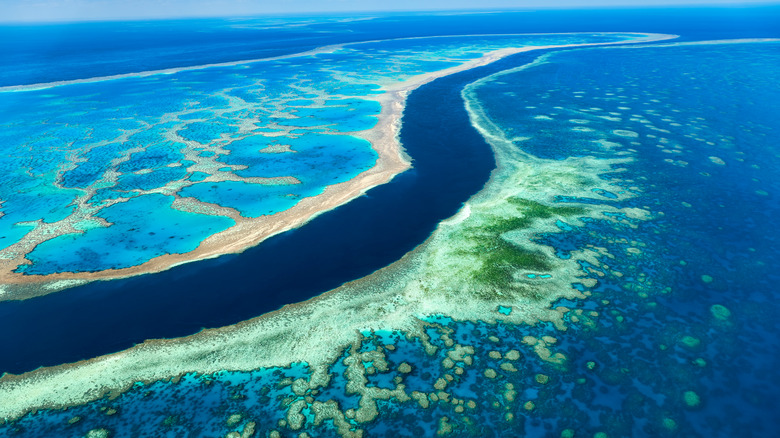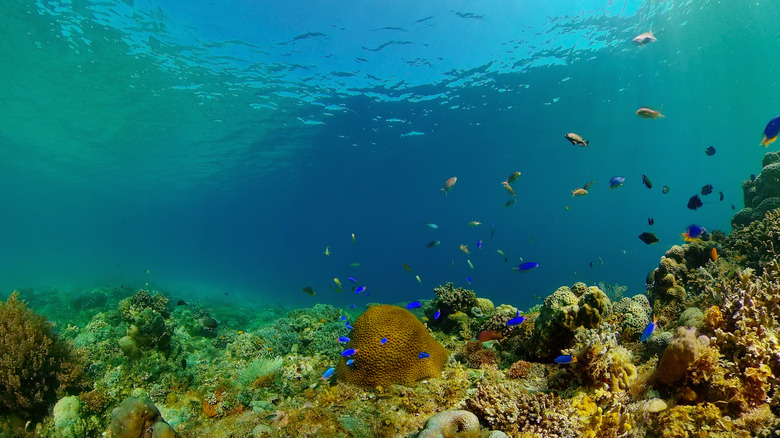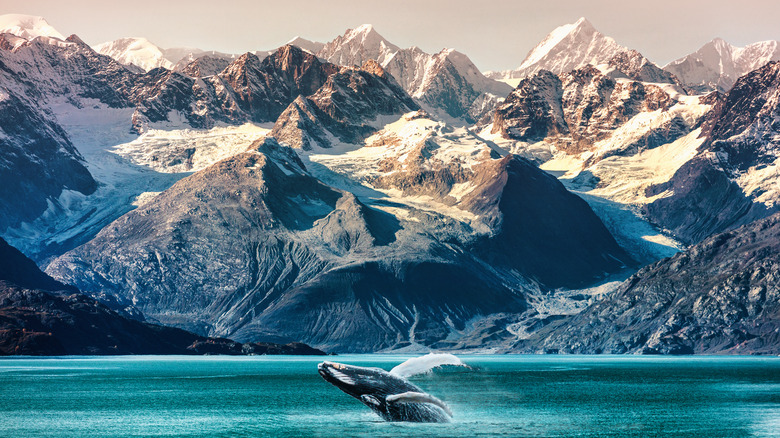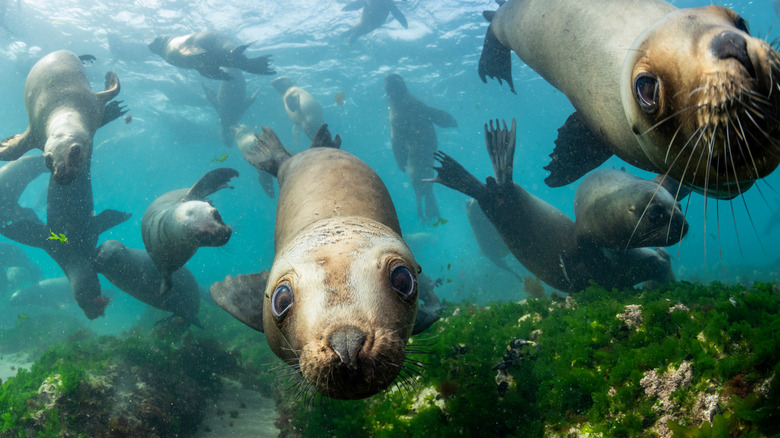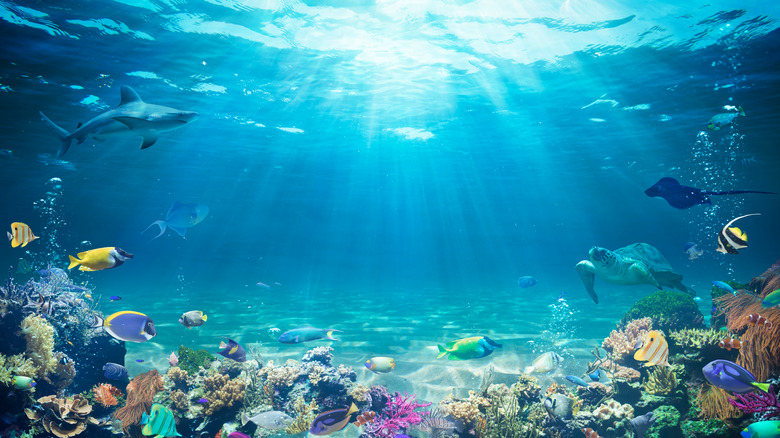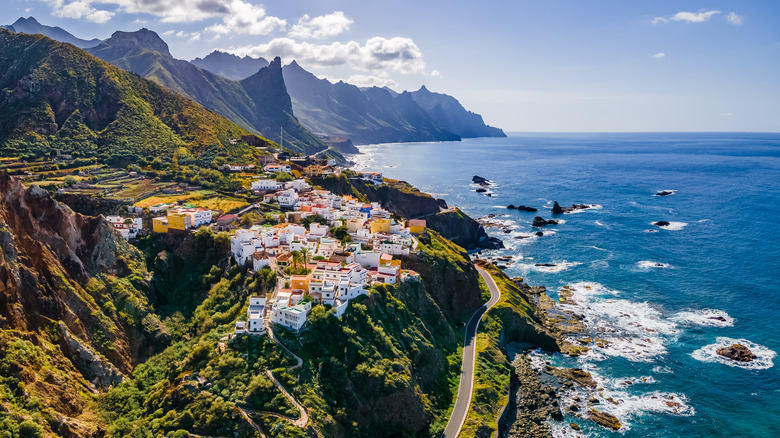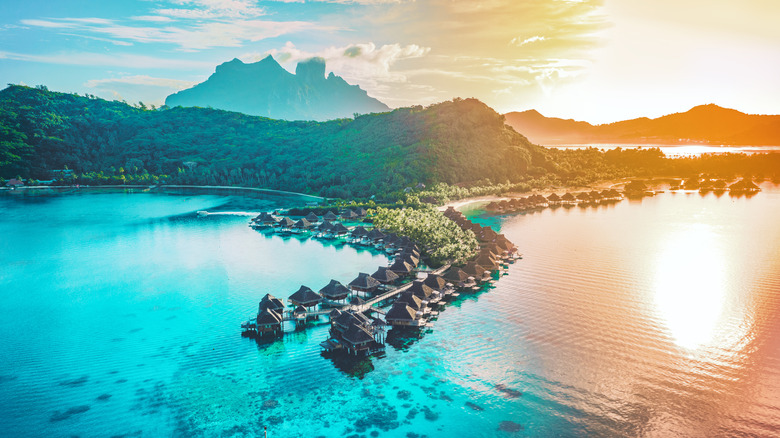The Largest Bodies Of Water On Earth Ranked By Size
What better time to celebrate Earth's bodies of water than the age of the Anthropocene? As Earth science weekly Eos explains, this is the current geological time, as coined by biologist Eugene Stoermer and chemist Paul Crutzen in 2000, and defined by humans' unprecedented impact on the planet.
Climate change and pollution are deeply affecting Earth's oceans. As per National Geographic, sea surface temperatures have been higher in the last 30 years than at any other time in recorded history. This destabilizes currents, creating more and more storms, and affects marine life.
As the glaciers are melting, sea levels are also rising at an unprecedented level, causing frequent floods. And because of pollution, the water also absorbs an increasing amount of carbon dioxide, which leads to ocean acidification, affecting corals and many other species. Finally, it affects us — as the UN Environment Programme reports, most of the oxygen we breathe is generated by oceans.
This doesn't have to be the end of our planet, though. According to Kurzgesagt, as of 2022, as the coal industry loses its global market share, renewable energy has become increasingly more affordable, as have batteries, giving hope to a future of electric cars and consequently, cleaner air. All this is good news for oceans as well, as the less we pollute, the more time we give our planet to regenerate. With hope and awe in mind, let's take a look now at Earth's largest bodies of water, as well as the marine life they contain, ranked by size.
13. The Tasman Sea (900,000 sq. miles)
An extension of the South Pacific Ocean, the Tasman Sea lies between Australia and New Zealand, per Marine Insight. The sea — as well as its neighboring island — got its name from Dutch explorer Abel Janszoon Tasman, who was the first European to reach the region in the mid-17th century. But this is hardly the most interesting fact about the Tasman Sea.
As per Britannica, it's the rough and diverse weather conditions that make the Tasman Sea a unique body of water. From January through June, a western Pacific stream influences the surface circulation, with a cold sub-Antarctic stream taking over the rest of the year. This means the southern Tasman sea has a temperate climate, but the northern side is subtropical.
Then there are the strong western currents, also known as the "roaring forties" (due to their positioning below 40 degrees south latitude) that make the Tasman Sea especially stormy. According to Marine Insight, it's between April and October that the sea becomes extremely turbulent, affecting the business at the ports located along its coasts.
12. The Caribbean Sea (1.063 million sq. miles)
The Caribbean Sea is so much more than the gorgeous golden-sand beaches that make up the body of water's outline. According to National Geographic, the sea is home to a wide variety of marine life, including coral reefs (14% of the world's coral reefs are found in the Caribbean Sea, per the World Wide Fund for Nature), beautiful Loggerhead turtles, and majestic reef sharks. One of the few seas that stretch over 1 million square miles, the Caribbean Sea is a basin belonging to the Atlantic Ocean. It's surrounded by the northern part of South America, the Yucatán Peninsula of Mexico, and the many Caribbean islands, imitating a necklace of beads that binds the sea on the northeastern side.
Together with the Gulf of Mexico, the Caribbean basin forms the Central American Sea. As Britannica explains, this is an area defined by huge population growth and heavy tourism. Luckily, this has triggered the formation of the Convention for the Protection and Development of the Marine Environment of the Wider Caribbean Region, or the Cartagena Convention. Since the 1980s, the Caribbean countries have been working to protect their waters by stopping oil spills, establishing protected areas, and reducing marine pollution.
11. The Weddell Sea (1.1 million sq. miles)
An extension of the Southern (or Antarctic) Ocean, the Weddell Sea is more ice than water, which basically makes it heaven for seals, but hell for boats. In fact, as per Britannica, the Weddell Sea is quite famous for the voyages it managed to stop in previous centuries. In 1820 alone, for example, the (soon to be Weddell) sea's ice stopped two voyages: the British brig Williams, and the Russian ship Vostok.
It was only three years later, however, that a British explorer named James Weddell managed to break through the ice, following a route to the sea's southernmost point (74 degrees 15 minutes south latitude and 34 degrees 17 minutes west longitude). Weddell initially named the body of water George IV, but at the turn of the 20th century, the George IV Sea became the Weddell Sea, honoring the explorer.
There's also a type of earless seal that bears the Weddell name, as it's only found on the coast of Antarctica. And of course, the Weddell Sea is home to several species of penguin, perhaps the animal most associated with the South Pole. Earth has warmed up considerably since 1823, but icebergs and glaciers are still the predominant landscape on the Weddell Sea. However, as Discovering Antarctica reports, these glaciers are slowly retreating and even collapsing — both the North and South poles are stark reminders of climate change.
10. The Mediterranean Sea (1.1 million sq. miles)
Per World Atlas, the Mediterranean Sea is an old place. It took shape during the late Triassic and the early Jurassic periods as a result of the African and Eurasian plates converging. The Mediterranean Sea is consequently a body of water filled with ancient and Medieval history — not only has it been around for quite some time, but its geographical positioning put it at the heart of Western civilization. Its very name, the Latin "mediterrāneus," means middle ("medius") earth ("terra").
Ancient Greece and the Roman Empire both relied on the Mediterranean Sea for its resources and valuable transport routes. But the Mediterranean Sea is just as valuable today. Situated between southern Europe, Asia Minor, and northern Africa, the sea still constitutes a rich ground for commercial fisheries, salt farms, and of course, tourism (via Britannica). As per Eco Union, in 2019, the Mediterranean region welcomed over 400 million tourists. Unfortunately, industrialization and tourism paired with weak currents make the Mediterranean Sea one of the most polluted bodies of water on Earth.
9. The South China Sea (1.351 million sq. miles)
The South China Sea is a huge extension of the Pacific Ocean, bordered by China and Vietnam in the west, Taiwan and the Philippines in the east, and Malaysia and Indonesia in the south. As explained by Britannica, in the South China Sea exists many submerged river valleys; these valleys have given the body of water various types of special sediments, such as mud around the Mekong Delta, clay in the deeper waters, and volcanic ash scattered throughout the sea, following the famous 1883 eruption of the Krakatoa volcano.
Over millions of years, the South China sea dropped about 2.5 miles (or 4 kilometers), leaving residual plateaus filled with numerous coral reefs, islets, and banks. According to National Geographic, the South China Sea has one of the most diverse coral reefs on Earth. Unfortunately, this also attracts a lot of poachers.
The South China basin is home to some 3,300 species of fish, but over 16 million tons are fished every year, and on top of that, poachers go to extreme lengths (e.g., dynamite fishing, reports the Observer Research Foundation) to secure the biggest clams and whatever species is on demand at a given time, per National Geographic. Needless to say, this destroys coral reefs and whole food chains.
In fact, more of the South China Sea's reefs were eradicated by clam poaching than by China's island-building. Thankfully, China is slowly taking measures to prevent poaching.
8. The Arabian Sea (1.5 million sq. miles)
The Indian Ocean's largest marginal basin, the Arabian Sea, is connected to the Persian Gulf and the Red Sea, and is surrounded by the Middle East and western India. Just like the Mediterranean Sea, this body of water has been a crucial trade route for centuries — millennia, actually, according to World Atlas. Ever since the third millennium BCE, people have been crossing the Arabian Sea, establishing a crucial connection between Europe and Asia, a connection that facilitated the very development of our societies.
The Arabian Sea is also known for its rich petroleum and natural gas deposits, which, perhaps unsurprisingly, have been heavily exploited in the last century (via Britannica). The Arabian Sea is also filled with a great variety of marine life, including the swift wahoo fish and the mysterious opah. But there is a strange phenomenon in the Arabian Sea: because of its monsoon climate, tropical waters, and oxygen-poor water surface, fish die en mass every so often. Strong upwelling brings the fish to the surface and they sadly suffocate.
7. The Coral Sea (1.85 million sq. miles)
The Coral Sea's hidden gem lies in its very name. As per Britannica, the South Pacific body of water contains the Great Barrier Reef, which is 1,200 miles long and runs along the northeastern Australian coast. As the Natural History Museum explains, corals are very important to Earth for a myriad of reasons: They protect coasts from big waves and storms, provide a source of income to millions of people, and of course, serve as a home to millions of animals who depend on reefs.
The Great Barrier Reef is home to 400 coral species, 1,500 fish species, 4,000 mollusk species and six sea turtle species — and among these, there are 300 threatened species. Sure enough, pollution, overfishing, and global warming affect Australia, too, so the country has been working hard to protect the Coral Sea.
In 2017, the United Nations reported that from 1980 on, the Great Barrier Reef had lost half of its coral cover. However, the reef is slowly regenerating, thanks to subsequent conservation efforts. The Great Barrier Reef Marine Park was founded in the 1980s, and since then, Australia has created the largest network of (protected) marine parks in the world.
6. The Philippine Sea (2.2 million sq. miles)
The largest sea in the world, the Philippine Sea stretches over 2 million square miles, with the Philippines making a wall between it and the South China Sea (via Marine Insight). Japan stands as the sea's northern border, with the Marianas in the east and the Palau archipelago in the south.
The Philippine Sea is a geological wonder: The body of water has active underwater volcanoes, and it's home to the deepest trenches on Earth, including the famous Mariana Trench. As per National Geographic, the Mariana Trench is 11,034 meters/36,201 feet deep, making it the deepest place on our planet, deeper than Mount Everest is high (if you juxtaposed Mount Everest on the trench, there would still be 2,133 meters/7,000 feet to go to the bottom).
The Philippine Sea — just like its namesake country — was named after King Philip II of Spain, explaining Spain's conquest of the Philippines in the 16th century, under explorer Ruy Lopez de Villalobos. The route had been set by Ferdinand Magellan in 1521, on the infamous journey where 250 men left and only 17 returned to Spain alive.
Sadly, the Philippines and its vast sea have been home to two horrific wars: First, there was the Spanish-Portuguese war in the 16th century, as a result of which the country became a Spanish colony. Then, there was the biggest carrier-to-carrier war in 1944, when the U.S. fought Japan in one of the largest and bloodiest World War II battles (via the National Park Service).
5. The Arctic Ocean (6.1 million sq. miles)
The Arctic Ocean, perhaps unsurprisingly, surrounds the Arctic. Until recently, this body of water wasn't the topic of many discussions, being the world's smallest ocean and basically, a huge icy patch with not a lot of navigation routes. But today, as the National Oceanic and Atmospheric Administration reports, it's the ocean most impacted by climate change, warming at a pace over twice the rate of any other place on Earth.
Tragically, this also means that the environmental changes, like the melting ice and warmer air, are too fast for the Arctic animals to adapt to. Today, polar bears, bearded seals, ringed seals, bowhead whales, and fin whales are protected as endangered species of the Arctic Ocean, but it'll take a lot of work to make sure they can survive and adapt to the fast-changing environment.
Rising greenhouse gas emissions from the tundra have also affected the Arctic Ocean, leading to ocean acidification, which deeply affects the 4 million people living and relying on the Arctic for its unique resources. As per National Geographic, the melting ice is also drawing navigation teams, tourists, and oil and gas exploitation. Meanwhile, we can expect harsher winters around the world as a consequence of the Arctic Ocean warming up. But there is hope: WWF Arctic has a strong program working since 1992 to protect the ocean, its wildlife, and human habitats.
4. The Southern Ocean (8.5 million sq. miles)
If you went to school anytime before 2021, you probably learned Earth only has four oceans. But as of June 8, 2021, a fifth one is officially recognized. As National Geographic reports, this is the Southern Ocean, which encircles the Antarctic, and stretches over 8 million square miles.
It's not that scientists weren't aware of this ocean until 2021. It's more that they finally agreed unanimously on the uniqueness of the waters surrounding the South Pole: "This change was taking the last step and saying we want to recognize it because of its ecological separation," explained NOAA scientist Seth Sykora-Bodie (via National Geographic), adding, "Anyone who has been there will struggle to explain what's so mesmerizing about it, but they'll all agree that the glaciers are bluer, the air colder, the mountains more intimidating, and the landscapes more captivating than anywhere else you can go."
According to Britannica, the Southern Ocean comprises one-sixteenth of Earth's ocean area and, unlike other oceans, it's not broken by any continents other than Antarctica — its borders are simply the Atlantic, Indian, and Pacific Oceans. National Geographic explains that the body of water is defined not by its borders, but by its unique Antarctic Circumpolar Current, making the Antarctic Ocean's waters colder and less salty than its neighboring oceans.
3. The Indian Ocean (27.24 million sq. miles)
Compared to the big Pacific and Atlantic Oceans, the Indian Ocean is the younger and smaller sibling. But in reality, it's a huge body of water making up a fifth of Earth's total water surface, as per Britannica. The Indian Ocean reaches a lot of countries: Oman, Yemen, and Saudia Arabia in the northeast; Africa's east coast in the west; India in the north; Malaysia, Indonesia, and Australia in the east. It's therefore no surprise that the ocean has great economic value, but that it's also at the heart of many conflicts.
As the Carnegie Endowment for International Peace explains, the Indian Ocean has several narrow straits that allow oil tankers to reach the whole world, and so economic conflicts over their control are dense. But it's not just the countries positioned on the straits that are engaged. In 2017, China set up a strong military facility in Djibouti, and in 2020, Russia opened a military base in Sudan, on the coast of the Red Sea, which flows into the Indian Ocean.
While the big political forces of the world battle over control of the ocean's borders — and millions of oil tankers pass through — the ocean and its wildlife suffer. According to World Atlas, the Indian Ocean is the second most polluted ocean in the world, holding 1.3 million pieces of plastic. And it's not just because of the tankers: the Indus and Ganges Rivers are among the world's most polluted, and they both drain into the Indian Ocean.
2. The Atlantic Ocean (41 million sq. miles)
The great "Sea of Atlas" — its name inspired by Greek mythology, per Britannica — is only second in size to the giant Pacific Ocean. Unlike the Pacific, the Atlantic Ocean is longer than wide, stretching all the way from the Arctic to Antarctica. The American continents comprise its western border, and Europe and Africa bind it to the east. It occupies a fifth of Earth's surface and it's home to countless currents that influence weather around the globe.
According to National Geographic, surface currents run quickly while deep currents run slower, and cold water is denser than warm water. So as salinity and temperatures flow into one another and move through the ocean as if following conveyer belts, they create wind streams and hurricanes on land. For example, Hurricanes Florence and Harvey were fueled by the warm waters in the Gulf of Mexico and the U.S. East Coast.
But perhaps the Atlantic Ocean's biggest marvel lies underwater: The Mid-Atlantic Ridge is a giant mountain range crossing the massive body of water from north to south, some 10,000 miles long and at times 1,000 miles wide (via Britannica). The abyssal hills and plains, as well as the shallow waters, are home to an enormous variety of marine animals, including the great white shark, which is finally making a comeback (via Discovery) as their numbers are on the rise in the U.S. part of the ocean.
1. The Pacific Ocean (60 million sq. miles)
According to National Geographic, all of Earth's landmasses together would fit comfortably inside the surface of the Pacific Ocean. The Pacific Ocean is the world's largest and deepest body of water, with Asia as its western border and America at the east. When explorer Ferdinand Magellan reached its calm waters in 1520 (following a pretty hectic voyage), he named it "pacific" (peaceful). But underneath lies the "Ring of Fire" — a 25,000-mile-long volcano chain that causes 90% of the world's earthquakes and comprises 75% of its volcanoes.
But the Pacific Ocean is also home to something much sadder: the Great Pacific Garbage Patch. As per World Atlas, it's as big as three Frances and it consists of 80,000 tons of plastic debris flowing freely between Hawaii and California. The Pacific Ocean is the world's most polluted body of water. This is a stark reminder of our unprecedented impact on the planet and an urgent call to action for all those who love the oceans and understand them as the irreplaceable sources of life they are.
